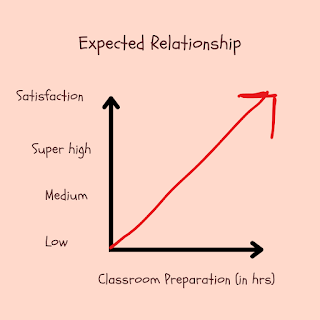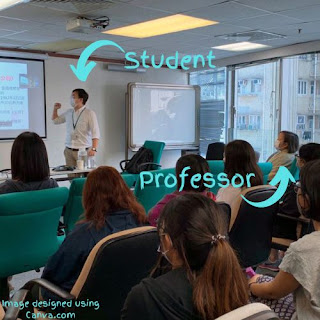The Surprising Relationship between Classroom Preparation and Teaching Satisfaction
I have been surprised at the relationship between the time I put into my face-to-face classes, and the satisfaction and fulfillment I get from those courses. I had expected a direct positive correlation, such that the more time I put into preparing for and planning my face-to-face courses, the better and more satisfied I feel about them. (I specify F2F because I think the relationship is different still in asynchronous courses. More on that to come.)
Figure 1. Expected Relationship Between Class Preparation and Satisfaction:
Sorry there are no actual hour denominations here. These would obviously change if
viewed on a daily, weekly, or semesterly basis.
Figure 1 shows what I expected to find. I designed this graph by extrapolating off of my early career experience that "the more prepared I feel, the better class goes." I had learned, for example, that the best classes were the ones that I came into having spent a few hours reading and thinking through the problems we'd discussed the previous class period. The worst classes were the ones I came into having not thought at all about the class beforehand.
I assumed that more would be better.
But I assumed wrong.
Figure 2. Actual Relationship Between Class Preparation and Satisfaction:
Ditto on denominations. I imagine it would change for each Prof, anyway.
How I went Overboard: What it Looked Like
To put some figures to what I'm describing, in advance of a given class I was spending around 30 minutes reflecting on how students were doing/feeling and another 90 minutes designing an activity based on the goal for the day and the affect of the class. So maybe 2 hours of preparation. (I always design new activities semester to semester, never recycling old ones.) Then I would arrive to find that students had moved on from where they had been the previous class period.
In the end, I think I was getting too caught up in everything being perfect. I was spending so much time getting the classroom mechanics right that I lost sight of the dynamic student personalities that comprised the class.
Finding the Sweet Spot
The solution, of course, isn't to spend zero time on preparation/planning in-between class periods. The solution is to find the sweet spot. I think this sweet spot is somewhere in-between the learning goal, your (the professor's) interests in the learning goal, and students' interest in the learning goal-- Remembering that the interests are always subject to change. Overanalyze these at your own peril.
In my experience, this means spending only enough time that I have captured my own interest in a learning goal, and to leave some room for students to modify this in their own way.
Example
For instance, say the goal for the day is "Learn how to cite using APA format." I would spend some time thinking about how I use APA format, like how I irksome I find reading something in MLA or with formatting errors. Also how I often have to consult the manual when editing a manuscript for publication, such as forgetting how many names to include for a multi-author in-text citation in the 7th version of APA. But also how big a deal college professors seem to make over APA formatting, as if failure to write in proper format is identical to writing in a foreign language.
If I go into class with a grasp on my own awareness of APA formatting (plus a knowledge of what it is and skill with doing it), then I'm prepared. If I create a survey to assess student interest levels, concerns, and knowledge with APA format to analyze ahead of class time, then I've taken it too far. Make sense?



Comments
Post a Comment